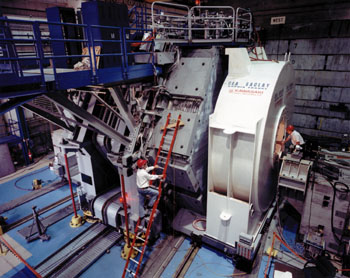This year’s major particle physics meeting showed that heavy “flavours”, whether they are strongly interacting quarks or weakly interacting leptons, are still very much at the cutting edge of today’s laboratory studies.

Heavy particles are hard to come by. As a result, precision measurements in this sector are widely admired and highly prized. This physics was a main focus at the International LeptonPhoton Symposium in Stanford. Existing experiments are homing in on the production of particles containing heavy quarks, and a series of major new experiments is being developed.
Spearheading this new generation of experiments are the B-factories at SLAC, Stanford and the Japanese KEK Laboratory. The electronpositron annihilations in these colliders PEP-II and KEKB respectively are a rich source of – particles that contain the fifth (“beauty”, “bottom” or simply “b”) quark. The decays of these B particles should reveal new insights into CP violation the subtle symmetry breaking assumed to be responsible for a matterantimatter symmetric Big Bang, which eventually produces a visible universe composed entirely of matter.
The other B physics players in the race include, notably, Cornell’s CESR electronpositron collider, which is equipped with the CLEO detector. CESR and CLEO have been working in tandem for some 20 years and have made a series of landmark contributions to B physics. Experiments at CERN’s LEP electronpositron collider have also made many valuable contributions to this work.
In the wings of the B stage is the HERA-B experiment at DESY, which uses the proton ring of the HERA collider. Fermilab’s Tevatron remains a source of a copious amount of heavy particles. Significant B physics potential is provided by the CDF and D0 detectors at Fermilab’s Tevatron protonantiproton collider, which is now fed by the new Main Injector. Detector upgrades and collision rate improvements will ensure that the Tevatron remains a focus of B physics.
For the future, the LHCb experiment at CERN’s LHC collider and the BTeV project at Fermilab are getting their acts together.
After a “Brief report from the B-factories”, an introduction to the leptonphoton symposium, attention was focused on heavy-quark physics. Ronald Poling of Minnesota showed how the experiments at CERN’s LEP electronpositron collider have charted semileptonic decays. The B physics scenarios, which have been explored at LEP at high energy and by CLEO at CESR via upsilon decays, are becoming increasingly reconciled with the LEP scenario, which is closer to theoretical predictions.
In measuring the parameters that describe the various interquark decays, CLEO has made charmless B decay (b quarks that decay directly into light quarks) its special hunting ground. In the more usual b decays (into charmed quarks) measurements from different experiments are converging.
While describing heavy-quark lifetimes and mixing, Guy Blaylock of Massachusetts highlighted valiant efforts to measure and understand why different charged states of heavy quarks have different lifetimes. In the present parametrization of quark decays, the mixing of B quarks is expected to be large, while that of D (charm) quarks is expected to be small. The former, says Blaylock, will lead to better measurements of the existing scheme, while the latter will provide a window for new physics effects.
And so to CP violation the subtle violation of a symmetry that, ideally, should reflect a particle into a mirror image of its antiparticle and vice versa. Two major experiments have recently announced new measurements of “direct” CP violation (CERN Courier September) brought about by quark transitions. Edward Blucher of Chicago spoke for the KTeV study at Fermilab and Giles Barr of CERN for the NA48 experiment. CERN experiments have had quantitative evidence of this effect since 1993, while a contemporary Fermilab experiment had published a result compatible with zero direct CP violation. After many years of anguished doubt, direct CP violation now looks here to stay. However, the years of dilemma underline the difficulty in making these measurements. With the objective of measuring direct CP violation to within 5%, both experiments have a lot more data to analyse. The CERN study continues.
Sergo Bertolucci described how the KLOE detector, at the new DAFNE phi factory at the Italian Frascati Laboratory, will explore additional aspects of neutral kaon physics via phi decays and could round off the kaon picture. Hopefully, B physics will soon open a new, and wider, window on CP violation, which has so far been confined to the strange world of the neutral kaon.
Complementary to the heavy quark is the heavy tau lepton, which is the only weakly interacting particle heavy enough to decay into strongly interacting particles. Tau specialist Antonio Pich of Valencia surveyed the tau scene at Stanford. Tau physics at electronpositron colliders, including spin effects, provides a valuable laboratory in which to explore the physics of weak interactions and the behaviour of heavy quarks.
“B decays, the unitarity triangle and the universe” was the challenging title assigned to Adam Falk of Johns Hopkins for his review of heavy-quark physics. The interrelation of the various possible quark decays has a self-consistent parametrization (the CabibboKobayashiMaskawa matrix), which gives some degree of predictive power but cannot be derived from first principles. What makes it work?
The imaginative title was a reference to the current dogma that CP violation, a mechanism that is much studied and well documented but still not entirely understood, is ultimately responsible for the disappearance of the antimatter half of the Big Bang.
The new B sector will subject this physics to much wider scrutiny and could reveal as yet unseen effects. Falk asked if the necessary formalism was ready to enable all of these processes to be analysed consistently.
At the turn of the millennium, heavy-quark physics is also poised to enter a new era.





